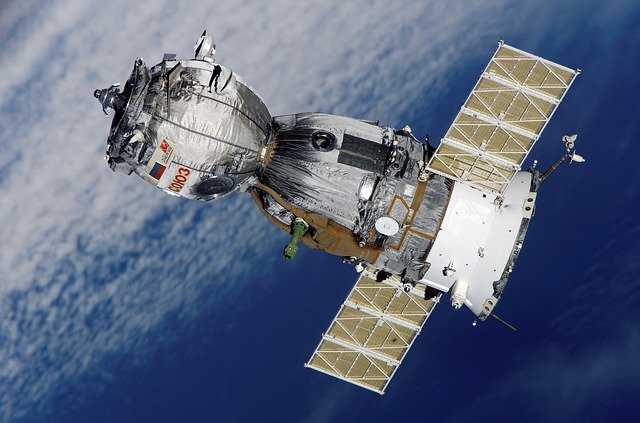*This post may contain affiliate links. This means we may make a commission if you purchase an item using one of our links*
Most satellites when acting on their own will travel around their respective planet in the same direction of the planet’s axial rotation, which will be from west to east (counterclockwise). This includes moons and artificial satellites orbiting any given planet however, the gas giants have multiple moons orbiting them in a retrograde motion, which would be in the opposite direction to the planets axial rotation.
There are satellites that follow different orbital patterns like polar or molniya orbits when explicitly designed to do so but, in most normal situations, natural and artificial satellites will orbit counterclockwise.
What Direction Do Satellites Travel?
Table of Contents
Moons and other satellites will orbit the earth from west to east, also regarded as counterclockwise.
All planets in our solar system spin around their axis from west to east, which is the same direction in which they orbit the Sun.
In that sense, the Sun also spins on its axis counterclockwise therefore, you could say that everything spins in the same direction as their parent star, whether it be natural satellites like moons orbiting their planet or artificial tech orbiting moons and planets.
This motion can also be referred to as a prograde motion.
There are the odd few planets that showcase a retrograde motion which creates an illusion that makes planets like Venus or Uranus for example look as if they are rotating in the opposite direction.
However, the reality of the situation is that Venus’ axial tilt of 177° and the effects of the sun slowing down its rotation makes it look as if it’s rotating clockwise when it isn’t. It’s just that the planet rotates so slowly or so fast that it looks like Venus is spinning in the opposite direction to most other planets.
Think of it like how a car’s tires look like they’re moving backward even though the car itself is moving forwards. It’s simply an optical illusion.
Another example would be if certain satellites move at a significantly slower rate than other objects which in turn makes it look as if they’re not moving at all, showcasing retrograde motion.
However, even if the pace at which any given satellite is moving is extremely slow, without the effect of any outside influences, they will always move from west to east.
With that being said, all satellites that have not been designed for a specific task will orbit in the same direction as a planet orbits its axis but, those specifically designed for different tasks will follow a different orbital pattern.
3 Different Orbital Patterns Satelites Follow
There are 3 different orbital patterns that man made satellites could follow in order to satisfy a specific agenda set by scientists.
Polar Orbit
A polar orbit is when satellites orbit between the north and south poles. This is done so accurate readings of weather conditions can be read, sometimes for military purposes (spying) and to take images of the Earth.
There are specific satellites like the Iridium satellite constellation that polar orbit which essentially supplies telecommunication services as well as data coverage for hundreds of millions to billions of individuals out there.
Molniya Orbit
Some satellites follow this orbital pattern which is essentially a very eccentric elliptical orbit.
Satelites that use this eccentric orbital pattern tend to provide access to a variety of services like television broadcasting, telecommunications, military communications, relaying, weather monitoring, early warning systems, etc.
Geosynchronous Orbit
This is a high latitude orbit that allows certain satellites to orbit Earth in the same way that most other satellites do from west to east. The satellites literally move at the same rate at which the earth spins therefore it would appear such satellites are stationed at a singular point at all times.
In turn, this means geosynchronous based telescopes can gather a lot of data on specific regions of Earth, whether it be to observe the activity of dangerous landmarks like volcanoes or monitoring the activity of certain countries that are high risk (military purposes).
How Close Are Satellites To Each Other?

Although there are a lot of satellites orbiting within Earth’s Hill sphere (6,542 satellites with 3,372 satellites active, and 3,170 satellites inactive), they are spaced quite a distance from each other, where on average the distance is roughly 73km between each of them.
This is only made possible due to the calculations experts in this field have made so, when new satellites are placed into orbit, it is carefully done to ensure a healthy separation is maintained.
Latitude, positioning and the purpose of any device is carefully observed otherwise, satellite debris finding its way into our atmosphere would be too common an occurrence.
How Often Do Satellites Orbit Earth In A Day?
The time taken for any given satellite to orbit Earth will be determined by the purpose of the given satellite. Geosynchronous satellites will orbit Earth once every 24 hours as their whole jig is to observe a singular region.
On the other hand, satelites following a polar orbit will complete a full cycle every 100 or so minutes.
As for satellites that follow the monliya orbital pattern, they will complete a full cycle within 12 hours.
Summary
In most cases, satellites will orbit their respective planet in the same direction that said planet orbits its axis, which is west to east or counterclockwise. Of course, this isn’t to say that certain objects can’t follow a different route, like iridium satellites that follow the polar orbit cycle.
Nevertheless, any naturally occurring satellite, which in the case for most planets would be the moons circling them, will travel in the same direction, even if some may be orbiting slower over others.

